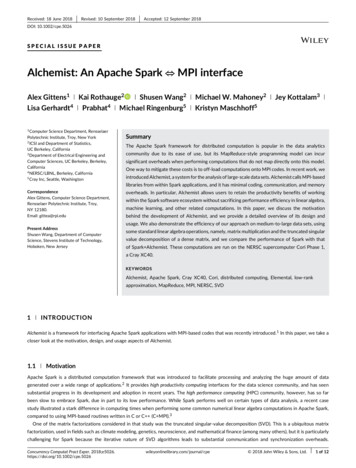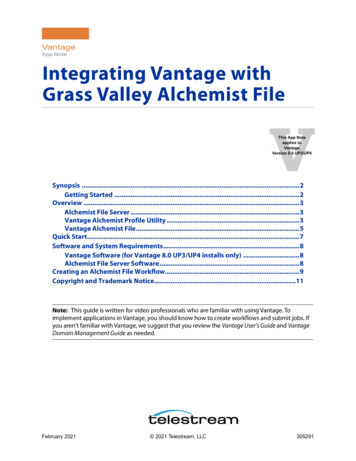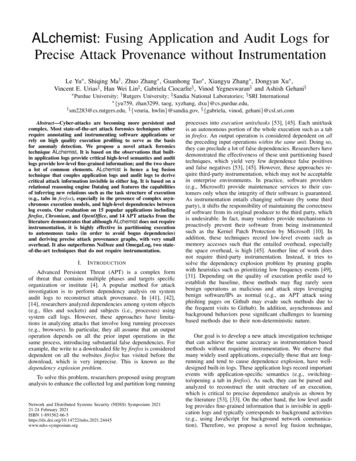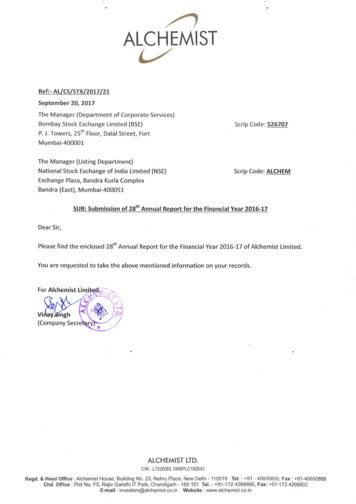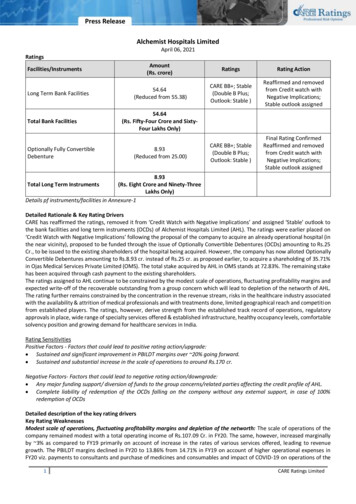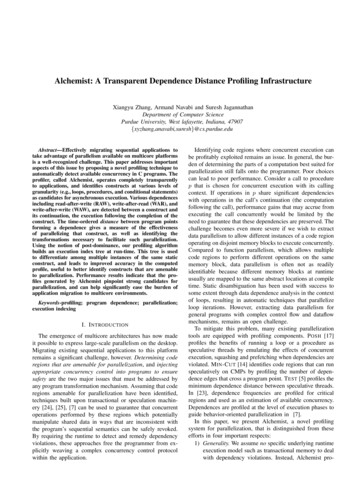
Transcription
Alchemist: A Transparent Dependence Distance Profiling InfrastructureXiangyu Zhang, Armand Navabi and Suresh JagannathanDepartment of Computer SciencePurdue University, West lafayette, Indiana, t—Effectively migrating sequential applications totake advantage of parallelism available on multicore platformsis a well-recognized challenge. This paper addresses importantaspects of this issue by proposing a novel profiling technique toautomatically detect available concurrency in C programs. Theprofiler, called Alchemist, operates completely transparentlyto applications, and identifies constructs at various levels ofgranularity (e.g., loops, procedures, and conditional statements)as candidates for asynchronous execution. Various dependencesincluding read-after-write (RAW), write-after-read (WAR), andwrite-after-write (WAW), are detected between a construct andits continuation, the execution following the completion of theconstruct. The time-ordered distance between program pointsforming a dependence gives a measure of the effectivenessof parallelizing that construct, as well as identifying thetransformations necessary to facilitate such parallelization.Using the notion of post-dominance, our profiling algorithmbuilds an execution index tree at run-time. This tree is usedto differentiate among multiple instances of the same staticconstruct, and leads to improved accuracy in the computedprofile, useful to better identify constructs that are amenableto parallelization. Performance results indicate that the profiles generated by Alchemist pinpoint strong candidates forparallelization, and can help significantly ease the burden ofapplication migration to multicore environments.Keywords-profiling; program dependence; parallelization;execution indexingI. I NTRODUCTIONThe emergence of multicore architectures has now madeit possible to express large-scale parallelism on the desktop.Migrating existing sequential applications to this platformremains a significant challenge, however. Determining coderegions that are amenable for parallelization, and injectingappropriate concurrency control into programs to ensuresafety are the two major issues that must be addressed byany program transformation mechanism. Assuming that coderegions amenable for parallelization have been identified,techniques built upon transactional or speculation machinery [24], [25], [7] can be used to guarantee that concurrentoperations performed by these regions which potentiallymanipulate shared data in ways that are inconsistent withthe program’s sequential semantics can be safely revoked.By requiring the runtime to detect and remedy dependencyviolations, these approaches free the programmer from explicitly weaving a complex concurrency control protocolwithin the application.Identifying code regions where concurrent execution canbe profitably exploited remains an issue. In general, the burden of determining the parts of a computation best suited forparallelization still falls onto the programmer. Poor choicescan lead to poor performance. Consider a call to procedurep that is chosen for concurrent execution with its callingcontext. If operations in p share significant dependencieswith operations in the call’s continuation (the computationfollowing the call), performance gains that may accrue fromexecuting the call concurrently would be limited by theneed to guarantee that these dependencies are preserved. Thechallenge becomes even more severe if we wish to extractdata parallelism to allow different instances of a code regionoperating on disjoint memory blocks to execute concurrently.Compared to function parallelism, which allows multiplecode regions to perform different operations on the samememory block, data parallelism is often not as readilyidentifiable because different memory blocks at runtimeusually are mapped to the same abstract locations at compiletime. Static disambiguation has been used with success tosome extent through data dependence analysis in the contextof loops, resulting in automatic techniques that parallelizeloop iterations. However, extracting data parallelism forgeneral programs with complex control flow and dataflowmechanisms, remains an open challenge.To mitigate this problem, many existing parallelizationtools are equipped with profiling components. P OSH [17]profiles the benefits of running a loop or a procedure asspeculative threads by emulating the effects of concurrentexecution, squashing and prefetching when dependencies areviolated. M IN -C UT [14] identifies code regions that can runspeculatively on CMPs by profiling the number of dependence edges that cross a program point. T EST [5] profiles theminimum dependence distance between speculative threads.In [23], dependence frequencies are profiled for criticalregions and used as an estimation of available concurrency.Dependences are profiled at the level of execution phases toguide behavior-oriented parallelization in [7].In this paper, we present Alchemist, a novel profilingsystem for parallelization, that is distinguished from theseefforts in four important respects:1) Generality. We assume no specific underlying runtimeexecution model such as transactional memory to dealwith dependency violations. Instead, Alchemist pro-
vides direct guidance for safe manual transformationsto break the dependencies it identifies.2) Transparency. Alchemist considers all aggregate program constructs (e.g., procedures, conditionals, loops,etc.) as candidates for parallelization with no need forprogrammer involvement to identify plausible choices.The capability of profiling all constructs is importantbecause useful parallelism can be sometimes extractedeven from code regions that are not frequently executed.3) Precision. Most dependence profilers attribute dependence information to syntactic artifacts such asstatements without distinguishing the context in whicha dependence is exercised. For example, althoughsuch techniques may be able to tell that there is adependence between statements x and y inside a loopin a function foo(), and the frequency of the dependence, they usually are unable to determine if thesedependences occur within the same loop iteration,cross the loop boundary but not different invocationsof foo(), or cross both the loop boundary and themethod boundary. Observe that in the first case, theloop body is amenable to parallelization. In the secondcase, the method is amenable to paralelization. Bybeing able to distinguish among these different formsof dependence, Alchemist is able to provide a moreaccurate characterization of parallelism opportunitieswithin the program than would otherwise be possible.4) Usability. Alchemist produces a ranked list of constructs and an estimated measure on the work necessary to parallelize them by gathering and analyzingprofile runs. The basic idea is to profile dependencedistances for a construct, which are the time spansof dependence edges between the construct and itscontinuation. A construct with all its dependencedistances larger than its duration is amenable forparallelization. The output produced by Alchemistprovides clear guidance to programmers on both thepotential benefits of parallelizing a given construct,and the associated overheads of transformations thatenable such parallelization.The paper makes the following contributions: Alchemist is a novel transparent profiling infrastructurethat given a C or C program and its input, producesa list of program points denoting constructs that arelikely candidates for parallelization. Alchemist treatsany program construct as a potential parallelizationcandidate. The implication of such generality is that adetected dependence may affect the profiles of multipleconstructs, some of whom may have already completedexecution. A more significant challenge is to distinguishamong the various dynamic nesting structures in whicha dependence occurs to provide more accurate and richer profiles. We devise a sophisticated online algorithm that relies on building an index tree on programexecution to maintain profile history. More specifically,we utilize a post-dominance analysis to construct a treeat runtime that reflects the hierarchical nesting structureof individual execution points and constructs.Alchemist supports profiling of Read-After-Write(RAW) dependences as well as Write-After-Write(WAW) and Write-After-Read (WAR) ones. RAW dependencies provide a measure of the amount of available concurrency in a program that can be exploitedwithout code transformations, while removing WARand WAW dependencies typically require source-levelchanges, such as making private copies of data.We evaluate profile quality on a set of programs thathave been parallelized elsewhere. We compare theprogram points highly ranked by Alchemist with thoseactually parallelized, and observe strong correlationbetween the two. Using Alchemist, we also manuallyparallelize a set of benchmarks to quantify its benefits.Our experience shows that, with the help of Alchemist,parallelizing medium-size C programs (on the orderof 10K lines of code) can lead to notable runtimeimprovement on multicore platforms.II. OVERVIEWOur profiling technique detects code structures that can berun asynchronously within their dynamic context. More precisely, as illustrated in Fig. 1, it identifies code structures likeC, delimited by Centry and Cexit , which can be spawnedas a thread and run simultaneously with C’s continuation,the execution following the completion of C. C can bea procedure, loop, or an if-then-else construct. Ourexecution model thus follows the parallelization strategyavailable using futures [10], [15], [25] that has been usedto introduce asynchronous execution into sequential Java,Scheme and Lisp programs; it is also similar to the behaviororiented execution model [7] proposed for C. A future joinswith its continuation at a claim point, the point at which thereturn value of the future is needed.Our goal is to automatically identify constructs that areamenable for future annotation and provide direct guidancefor the parallelization transformation. The basic idea is toprofile the duration of a construct and the time intervalsof the two conflicting memory references involved in anydependence from inside the construct to its continuation.Consider the sequential run in Fig. 1. Assume our profilingmechanism reveals a dependence between execution points xand y. The duration of construct C and the interval betweenx and y are profiled as Tdur and Tdep , respectively. Let thetimestamps of an execution point s in the sequential and theparallel executions be tseq (s) and tpar (s), respectively; theinterval between x and y in the parallel run is then
durCcontinuationParallelyCentryFigure 1.Overview (the dashed lines represent the correspondence between execution points).Source Position84711. int zip (in, out)84722. {while (/* input buffer not empty*/) { 16003./* process one literal at a time*/ 4.if (/*processing buffer full*/)16625.flush block (&window[], );16626.flag buf[last flags ] ;66297.}17018. flush block (&window[], );17049.852710. outbuf[outcnt ] /*checksum*/}Profile1. Method main2. Loop (main,3404) 9. Method flush blockRAW: line 29RAW: line 28RAW: line 14RAW: line 22 CexitxTdur 20432742, inst 1Tdur 20431181, inst 1Tdur 643408, line 9 line 10 line 14 line 19inst 2Tdep 1Tdep 3Tdep 4541215Tdep 4541231Figure 2.Source Position649611. off t flush block (buf, len, )649512. {flag buf[last flags] /*the current flag*/; 650513.6528input len /* length of the block*/;14.15. /* Encode literals to bits*/6670do {16.6671 flag flag buf[ ];17.6673if (flag ) {18.754if (bi valid ) {19.outbuf[outcnt ] (char) bi buf ; 75620.757bi buf /* encoding*/;21.758bi valid ;22.759}23.}24.6698} while (/*not the last literal*/);25.6064last flags 0;26. 27. /* Write out remaining bits*/790outbuf[outcnt ] (char) bi buf ;28.6597return /* # of compressed literals*/;29.}Profiling gzip-1.3.5.tpar (y) tpar (x) (tseq (y) (tseq (Cexit ) tseq (Centry ))) tseq (x) (tseq (y) tseq (x)) (tseq (Cexit ) tseq (Centry )) Tdep Tduras shown in Fig. 1.The profile and the dependence types provide guidance toprogrammers as follows. For RAW dependences, i.e., x is a write and y is aread of the same location, if Tdep Tdur , constructC is a candidate for asynchronous evaluation with itscontinuation. That is because it indicates the distancebetween x and y is positive in the parallel run, meaningit is highly likely that when y is reached, C has alreadyfinished the computation at x and thus dependence canbe easily respected. A simple parallelization transfor- mation is to annotate C as a future, which is joinedat any possible conflicting reads e.g., y. More complextransformations that inject barriers which stall the readat y until it is guaranteed that C will perform no furtherwrites to the same location (e.g., x has completed) arealso possible.For WAR dependences, i.e., x is a read and y is a write,if C has been decided by the RAW profile to be parallelizable, two possible transformations are suggestedto the programmer. The first one is for dependenceswith Tdep Tdur , which implies that if the constructis run asynchronously, the write may happen beforethe read and thus the read may see a value from itslogical future, violating an obvious safety property.Therefore, the programmer should create a private copyof the conflict variable in C. For dependences withTdep Tdur , the programmer can choose to join the
asynchronous execution before y.WAW dependences are similar to WAR.Consider the example in Fig. 2, which is abstracted fromthe single file version of gzip-1.3.5 [1]. It contains twomethods zip and flush block. To simplify the presentation, we inline methods called by these two proceduresand do not show statements irrelevant to our discussion.The positions of the statements in the source that are shownin the code snippet are listed on the right. Procedure zipcompresses one input file at a time. It contains a while loopthat processes the input literals, calculating the frequenciesof individual substrings and storing literals into temporarybuffers. Whenever these buffers reach their limits, it callsprocedure flush block to encode the literals and emitthe compressed results at line 6. During processing, thewhile loop sets flags[] which will be used later duringencoding. The procedure flush block first records thecurrent flag and updates the number of processed inputsat lines 13-14; it scans the input buffer within the loop atlines 16-25, encodes a literal into bits stored within bufferbi buf, which is eventually output to buffer outbufat line 20. Variable bi valid maintains the number ofresult bits in the buffer, and outcnt keeps track of thecurrent pointer in the output buffer. After all the literals areprocessed, the procedure resets the last flags variableat line 26 and emits the remaining bits in the bit buffer. Notethat at line 20 in the encoding loop, bits are stored to theoutput buffer at the unit of bytes and thus at the end, thereare often trailing bits remaining. The number of compressedliterals is returned at line 29.The code in Fig. 2 is significantly simplified from theactual program, which is comprised of much more complexcontrol flow and data flow, both further confounded byaliasing. It is difficult for traditional static techniques toidentify the places where concurrency can be exploited.Running gzip with Alchemist produces the results shownin Fig. 2. Each row corresponds to a source code construct.The profile contains Tdur , approximated by the number ofinstructions executed inside the construct and the numberof executions of the construct. For example, the first rowshows that the main function executes roughly 20 millioninstructions once. The second row shows that the loopheaded by line 3404 in the original source executes roughly20 million instructions once, i.e. there is one iteration of theloop.Let us focus on the third row, which corresponds to theexecution of calls to procedure flush block. From theprofile, we see the procedure is called two times – the firstcall corresponds to the invocation at line 6, and the other atline 9. Some of the profiled RAW dependences between theprocedure and its continuation are listed. Note that while onedependence edge can be exercised multiple times, the profileshows the minimal Tdep because it bounds the concurrencythat one can exploit. We can see that only the first two (out of a total of fifteen) dependences, highlighted by the box,do not satisfy the condition Tdep Tdur , and thus hinderconcurrent execution. Further inspection shows that the firstdependence only occurs between the call site at line 9, whichis out of the main loop in zip(), and the return at 29. Inother words, this dependence does not prevent the call at 6from being spawned as a future. The second dependenceis between the write to outcnt at 28 and the read at10. Again, this dependence only occurs when the call ismade at line 9. While these dependencies prevent the call toflush block on line 9 from running concurrently withits continuation (the write to outbuf), it does not addressthe calls to flush block made at line 6. Because thesecalls occur within the loop, safety of their asynchronousexecution is predicated on the absence of dependenceswithin concurrent executions of the procedure itself, as wellas the absence of dependencies with operations performedby the outer procedure. Snippets of the profile show that theoperation performed at line 14 has a dependence with itselfseparated by an interval comprising roughly 4M instructions.Observe that the duration of the loop itself is only 2Minstructions, with the remaining 2M instructions comprisedof actions performed within the iteration after the call. Alsoobserve that there is no return value from calls performedwithin the loop, and thus dependencies induced by suchreturns found at line 9, are not problematic here.Method flush blockWAW: line 28WAR: line 17WAR: line 26WAR: line 17 Figure 3.Tdur 643408, line 10 line 7 line 7 line 13inst 2Tdep 7Tdep 6702Tdep 6703Tdep 3915860WAR and WAW profile.Besides RAW dependencies, Alchemist also profiles WARand WAW dependencies. Unlike a RAW dependence whichcan be broken by blocking execution of the read access untilthe last write in the future upon which it depends completes,WAR and WAW dependencies typically require manifestcode transformations. The WAR and WAW profile for gzipis shown in Fig. 3. The interesting dependences, namelythose which do not satisfy Tdep Tdur , are highlighted inthe box. The first dependence is between the two writesto outcnt at 28 and 10. Note that there are no WAWdependences detected between writes to outbuf as theywrite to disjoint locations. Another way of understanding itis that the conflict is reflected on the buffer index outcntinstead of the buffer itself. As before, this dependence doesnot compromise the potential for executing calls initiatedat 6 asynchronously. The second dependence is causedbecause the read to flag buf[] happens at 17 andthe write happens later at 7. While we might be able to
inject barriers between these two operations to prevent adependence violation, a code transformation that privatizesflag buf[] by copying its values to a local array isa feasible alternative. Similarly, we can satisfy the thirddependence by hoisting the reset of last flags frominside flush block () and put it in the beginningof the continuation, say, between lines 6 and 7. In themeantime, we need to create a local copy of last flagsfor flush block(). While the decision to inject barriersor perform code transformations demands a certain degree ofprogrammer involvement, Alchemist helps identify programregions where these decisions need to be made, alongwith supporting evidence to help with the decision-makingprocess. Of course, as with any profiling technique, thecompleteness of the dependencies identified by Alchemistis a function of the test inputs used to run the profiler.(a)codeTrace1.2.3.4.5.6.7.void A ( ) {s1;B ( );}void B( ) {s2;}2362(c)void C ( ) {if ( ) {s3;if ( )s4;}}2345AIndex(b)1.2.3.4.5.6.7.1. void D ( ) {2.while ( ) {3.s5;4.while ( )5.s4;6.}7. }23454542CD22B443 62 3 4 52 3 4 5Figure 4.4454 2Execution Indexing Examples.III. T HE P ROFILING A LGORITHMMost traditional profiling techniques simply aggreate information according to static artifacts such as instructionsand functions. Unfortunately, such a strategy is not adequatefor dependence profiling. Consider the example trace inFig. 4 (c). Assume a dependence is detected between thesecond instance of 5 in the trace and the second instanceof 2. Simply recording the time interval between the twoinstances or increasing a frequency counter is not sufficientto decide available concurrency. We need to know that thedependence indeed crossed the iteration boundaries of loops2 and 4. This information is relevant to determine if theiterations of these loops are amenable for parallelization. Incontrast, it is an intra-construct dependence for procedureD and can be ignored if we wish to evaluate calls to Dconcurrently with other actions. Thus, an exercised dependence edge, which is detected between two instructions, hasvarious implications for the profiles of multiple constructs.The online algorithm has to efficiently address this issue.A. Execution IndexingRAW, WAR, and WAW dependences are detected betweenindividual instructions at run time. Since our goal is toidentify available concurrency between constructs and theirfutures, intra-construct dependences can be safely discarded.An executed instruction often belongs to multiple constructsat the same time. As a result, a dependence may appear asan intra-construct dependence for some constructs, and as across-boundary dependence for others.In order to efficiently update the profile of multiple constructs upon detection of a dependence, we adopt a techniquecalled execution indexing [26] to create an execution indextree that represents the nesting structure of an executionpoint. Fig. 4 shows three examples of execution indexing.In example (a), node A denotes the construct of procedureA. As statements 2 and 3 are nested in procedure A, theyare children of node A in the index tree. Procedure B isalso nested in A. Statement 6 is nested in B. The indexfor an execution point is the path from the root to thepoint, which illustrates the nesting structure of the point.For example, the index of the first instance of statement 6in trace (a) is [A, B]. Fig. 4 (b) shows an example for anif-then-else construct. The construct led by statement2 is nested in procedure C(), and construct 4 is nestedwithin construct 2, resulting in the index tree in the figure.Note that statement 2 is not a child of node 2, but a childof node C because it is considered as being nested in theprocedure instead of the construct led by itself. Example(c) shows how to index loops. Since loop iterations areoften strong candidates for parallelization, each iterationis considered as an instance of the loop construct so thata dependence between iterations is considered as a crossboundary dependence and hence should be profiled. We cansee in the index tree of example (c), the two iterations ofloop 4 are siblings nested in the first iteration of 2. Theindex of 52 (the second instance of statement 5) is [D, 2, 4],exactly disclosing its nesting structure. From these examples,we observe that (i) a dynamic instance of a construct isrepresented by a subtree; (ii) the index for a particularexecution point is the path from the root to this point.While Fig. 4 only shows simple cases, realistic applications may include control structures such as break,continue, return, or even long jump/ set jump;a naive solution based on the syntax of the source codewould fail to correctly index these structures. Control flowanalysis is required to solve the problem. The intuition isthat a construct is started by a predicate and terminatedby the immediate post-dominator of the predicate. Similarto calling contexts, constructs never overlap. Therefore, asimilar stack structure can be used to maintain the currentindex of an execution point. More precisely, a push isperformed upon the execution of a predicate, indicating thestart of a construct. A pop is performed upon the execution
of the immediate post-dominator of the top construct on thestack, marking the end of that construct. The state of thestack is indeed the index for the current execution point.Rule(1)(2)(3)(4)EventEnter procedure XExit procedure XNon-loop predicate at pLoop predicate at p(5)Statement sInstrumentationIDS.push(X)IDS.pop()IDS.push(p)if (p IDS.top()) IDS.pop();IDS.push(p)while (p IDS.top() s is the immediatepost-dominator of p) IDS.pop()*IDS is the indexing stack.Figure 5.Instrumentation Rules for Indexing.The instrumentation rules for execution indexing are presented in Fig. 5. The first two rules mark the start andend of a procedure construct by pushing and popping theentry associated with the procedure. In rule (3), an entry ispushed if the predicate is not a loop predicate. Otherwise inrule (4), the top entry is popped if the entry corresponds tothe loop predicate of the previous iteration, and the currentloop predicate is then pushed. Although rule (4) pushes andpops the same value, it is not redundant as these operationshave side effects, which will be explained next. By doing so,we avoid introducing a nesting relation between iterations.Finally, if the top stack entry is a predicate and the currentstatement is the predicate’s immediate post-dominator, thetop entry is popped (Rule 5). Irregular control flows such asthose caused by long jump and set jump are handledin the same way as that presented in [26].Managing the Index Tree for an Entire Execution.Unfortunately, the above stack-based method that is similarto the one proposed in [26] only generates the index for thecurrent execution point, which is the state of the index stack.It does not explicitly construct the whole tree. However, inAlchemist, we need the tree because a detected dependencemay involve a construct that completed earlier. For instance,assume in the execution trace of Fig. 4 (c), a dependence isdetected between 51 and 22 . The index of 51 is [D, 2, 4]. Itis nested in the first iteration of loop 4, which has completedbefore 22 , and thus its index is no longer maintained by thestack. In order to update the right profiles, 51 ’s index needsto be maintained.A simple solution is to maintain the tree for the entireexecution. However, doing so is prohitively expensive andunnecessary. The key observation is that if a constructinstance C has ended for a period longer than Tdur (C),the duration of the construct instance, it is safe to removethe instance from the index tree. The reason is that anydependence between a point in C and a future point, mustsatisfy Tdep Tdur (C) and hence does not affect theprofiling result. The implication is that the index tree can bemanaged by using a construct pool, which only maintainsthe construct instances that need to be indexed. Since onenode is created for one construct instance regardless ofTable IThe Algorithm for Managing the Index Tree.pc is the program counter of the head of the construct.PROFILE constrains the profile for constructs, indexed by pc.pool is the construct pool.1: IDS.push (pc)2: {3:c pool .head();4:while (timestamp c.Texit c.Texit c.Tenter ) {5:c pool .next();6:}7:pool .remove(c);8:c.label pc;9:c.Tenter timestamp;10:c.Texit 0;11:c.parent IDS[top-1];12:IDS[top ] c;13: }14:15: IDS.pop ()16: {17:c IDS[ top];18:c.Texit timestamp;19:pc c.label;20:PROFILE[pc].Ttotal c.Texit -c.Tenter ;21:PROFILE[pc].inst ;22:pool .append(c)23: }the Tdur of the construct, only those constructs that getrepeatedly executed have many instances at runtime and posechallenges to index tree management.Theorem 1: Assume the maximum size of an instanceof a repeatedly executed construct is M , a statement canserve as the immediate post-dominator for a maximum of Nconstructs, and the maximum nesting level is L. The memoryrequirement of Alchemist is O(M · N L).Proof: Let i be the instruction count of an executionpoint, constructs completed before i M are of no interestbecause any dependence between i and any point in thoseconstructs must have Tdep M . Thus, only constructs thatcompleted between i M and i need to be indexed withrespect to i, i.e., the nodes for those constructs can notbe retired. As the maximum number of constructs that cancomplete in one execution step is N according to rule (5) inFig. 5, the number of constructs completed in that durationcan not exceed M · N . Since L is the maximum number ofactive constructs, i.e., constructs that have not terminated,the space complexity is O(M · N L).The theorem says that the memory requirement of Alchemist is bounded if the size of any repeatedly executedconstruct is bounded. In our experiment, a pre-allocated poolof the size of one million dynamic constructs never led tomemory exhaustion. The pseudo-code for the algorithm ispresented in Table I. It consists of two functions: IDS.pushand IDS.pop. In the instrumentation rules presented earlier,they are the push and pop operations of the index stack.
In the algorithm, variable pool denotes the construct pool.Upon calling the push operation with the program counterof the head instruction of a construct, usually a predicate ora function entry, the algorithm finds the first available construct from the pool by testing if it satisfies the condition atline 4. Variable timestamp denotes the current time stamp.It is simulated by the number of executed instructions. If thepredicate is true, c can not be retired and the next constructfrom pool is tested. The first construct th
Alchemist is a novel transparent profiling infrastructure that given a C or C program and its input, produces a list of program points denoting constructs that are likely candidates for parallelization. Alchemist treats any program construct as a potential parallelization candidate. The implication of such generality is that a
